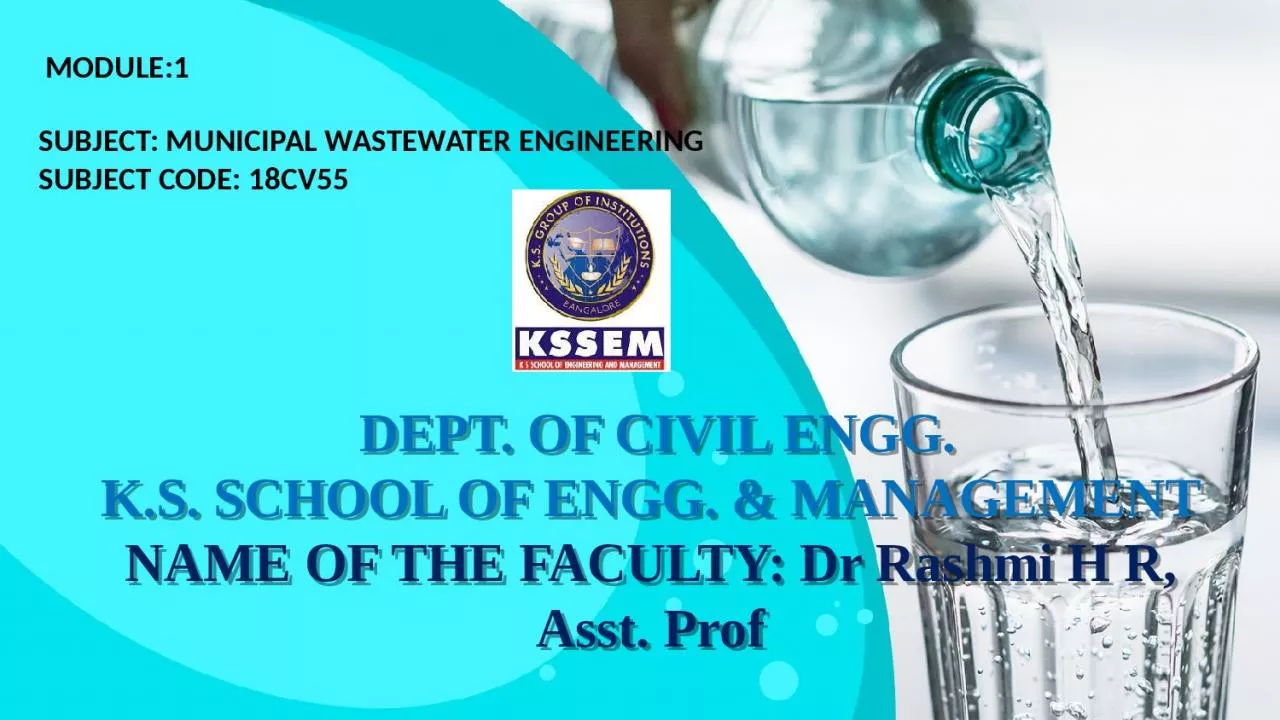

KS SCHOOL OF ENGG amp MANAGEMENT NAME OF THE FACULTY Dr Rashmi H R Asst Prof MODULE1 SUBJECT MUNICIPAL WASTEWATER ENGINEERING SUBJECT CODE 18CV55 TOPICS NEED FOR SANITATION ID: 1022163
Download Presentation The PPT/PDF document "DEPT. OF CIVIL ENGG." is the property of its rightful owner. Permission is granted to download and print the materials on this web site for personal, non-commercial use only, and to display it on your personal computer provided you do not modify the materials and that you retain all copyright notices contained in the materials. By downloading content from our website, you accept the terms of this agreement.
1. DEPT. OF CIVIL ENGG.K.S. SCHOOL OF ENGG. & MANAGEMENTNAME OF THE FACULTY: Dr Rashmi H R,Asst. ProfMODULE:1SUBJECT: MUNICIPAL WASTEWATER ENGINEERINGSUBJECT CODE: 18CV55
2. TOPICSNEED FOR SANITATION METHODS FOR SEWAGE DISPOSALTYPES OF SEWAGE SYSTEMDRY WEATHER FLOWWET WEATHER FLOWFACTOR AFFECTING DRY WEATHER FLOW AND WET WEATHER FLOW
3. NEED FOR SANITATION Proper disposal of human excreta to safe place before it starts decomposing and cause insanitary conditions.To take out all kinds of wastewater immediately ,so that mosquitos , bacteria etc , should not breed in it.Final disposal of sewage on land or in nearby waterbodies should be treated , so that receiving land or water may not get polluted for further use.
4.
5. METHODS OF SEWAGE DISPOSALThere are two types of methods of sewage disposal are; 1] CONSERVANCY SYSTEM 2] WATER CARRIAGE SYSTEM
6. CONSERVANCY SYSTEM In this system types of refuse and storm water is collected , conveyed and disposed separately by various methods . This method was in practice in ancient times .In present also this method is in practice in small towns , villages etc …..
7. ADVANTAGES OF CONSERVANCY SYSTEMInitial cost is low .The quality of sewage reaching at the treatment before disposal is low .DISADVANTAGES OF CONSERVANCY SYSTEM Possibility of storm water may mix with sewers and cause heavy load on treatment plant .In crowded lanes it is difficult to provide two different sewers .Decomposition of sewage may cause insanitary conditions and dangerous for human health .
8. WATER CARRIAGE SYSTEM In this system , the excremental matters are mixed up in large quantity of water and are taken out of the city through proper drainage system and disposed off after necessary treatment .The sewage consists of 99.9% of water and 0.1% of solids. This system is universally used now a days .
9.
10. ADVANTAGES OF WATER CARRIAGE SYSTEMIt is hygienic method because all excremental matters are collected and disposed by water.Less space is occupied as only one sewer is laid .The land required for disposal work is less as compared to conservancy system .DISADVANTAGES OF WATER CARRIAGE SYSTEMThis system is very costly in initial cost.The maintainance of system also very costly .
11. TYPES OF SEWER SYSTEMSeparate systemCombined systemPartially separate system
12. SEPARATE SEWER SYSTEMIn this system two sets of sewers are laid for drainage and sewage.Drainage and sewage are taken independently of each other through these two different sets of conduits.The sewage is carried to the treatment plant and storm water is disposal of to water
13.
14. COMBINED SYSTEMIn this system only one set of sewers are used to carry both sanitary sewage and surface water.Sewage and storm water both are carried to the treatment plant through combined sewers.
15.
16. PARTIALLY SEPARATE SYSTEMA portion of storm water during rain such that the water originating from roof tops and paved courtyards is allowed to enter sanitary sewer to treatment plants. Thus by diluting the waste concentration
17. DRY WEATHER FLOWIt is the quantity of water that flows through a sewer in dry weather when no storm water is in the sewer.It is also known as sanitary sewage.
18. SOURCESDomestic waste water: the waste water reaching sewer due to domestic activities such as bathing, washing clothes and vessels etc.Industrial waste water: the waste water generated due to manufacturing process in industries .Waste water from public facilities: that is the waste water generated from school, cinemas , hotels etc.ground water infiltration: infiltration of gw depends upon the nature of soil, materials of sewer, nature and condition of sewer joints, depth of sewer
19. WET WEATHER FLOWThe amount of rain water flowing over the ground surface, pavements , house roofs etc..,is commonly known as runoff or storm water. this storm water is ultimately drained through the sewer ;the amount of peak storm water flow is several times more than of DWF.This storm water flow is also known as wet weather flow
20. FACTOR AFFECTING THROUGH DWFRate of water supply: the quantity of used water discharged into sewer system is little less than the amount of water supplied to community.Population growth: the quantity of sanitary sewage directly depends on the population .Type of area served: if the area served is residential, the waste water produced is assumed to be equal to 70 % to 80 %Infiltration of ground water: infiltration of water into sewer through joints increases the quantity of sewage
21. FACTOR AFFECTING THROUGH WWFCatchment areaGround slopePermeability of groundExtent of vegetation growthRainfall intensityRainfall durationCondition of ground prior to rainfallConcentration of catchment areaClimatic condition such as wind, temperature , humidity etc..,
22. Useful linkhttps://www.youtube.com/watch?v=YegffvYy8OY&list=PLq46p_ppqQemlLzkiMgKtPkkLWOKgN1kThttps://www.youtube.com/watch?v=zVZ9c6EXfTAhttps://www.youtube.com/watch?v=We9BvA814gk